Cave paintings are prehistoric paintings and drawings that were created on cave walls and ceilings, some of which date back to as early as 40,000 years ago.
These paintings are found in caves all over the world, although the most famous examples are located in France and Spain.
Collectively called parietal art (from the Latin parietalis, or “relating to walls”), the ancient paintings and engravings left by our distant ancestors actually speak of rich religious beliefs and strong cultural life. More than simple doodles, they are landmarks on the road from our most primitive beginnings to the development of civilization itself.
Table of Contents
What are Cave Paintings?
Cave paintings are a form of prehistoric art found in various caves and rock shelters around the world. They are some of the earliest known examples of human artistic expression and date back tens of thousands of years. These paintings were created by ancient civilizations using natural pigments and materials available to them at the time.
Cave paintings provide valuable insights into the lives, beliefs, and artistic capabilities of our ancient ancestors and continue to be an essential source for understanding prehistoric cultures and societies.
Cave Paintings in Europe
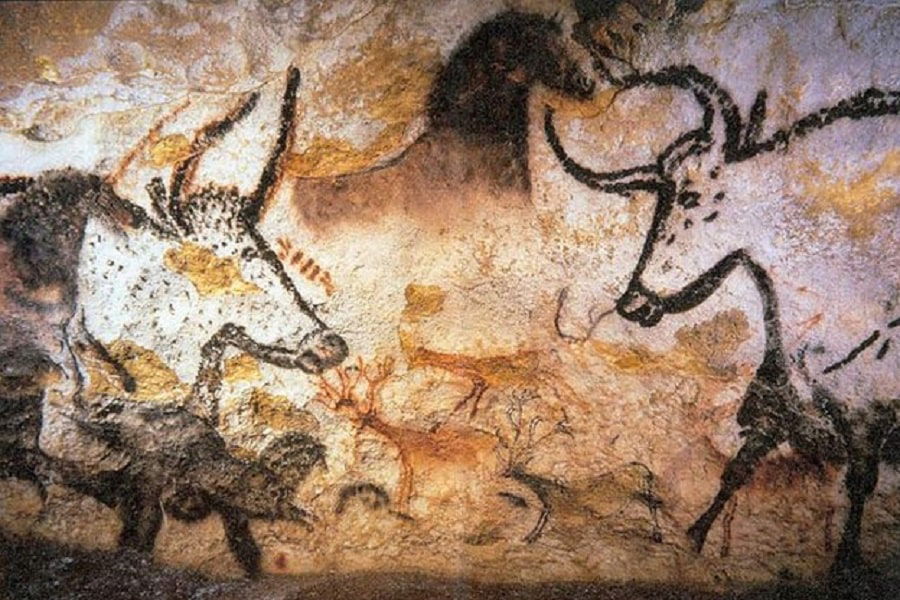
The most famous cave paintings in the world are those found in the cave known as Lascaux in southwestern France. Discovered by accident in 1940 by teenage boys, the Lascaux cave network boasts thousands of paintings, including almost a thousand depictions of animals.
Originally open to the public, the caves were closed to visitors in 1963 to avoid further damage to the paintings from artificial lights, humidity, and heat the crowds brought. Both permanent and traveling exhibits of reproductions of the Lascaux cave paintings have been available since the 1980s.
The Art of Lascaux
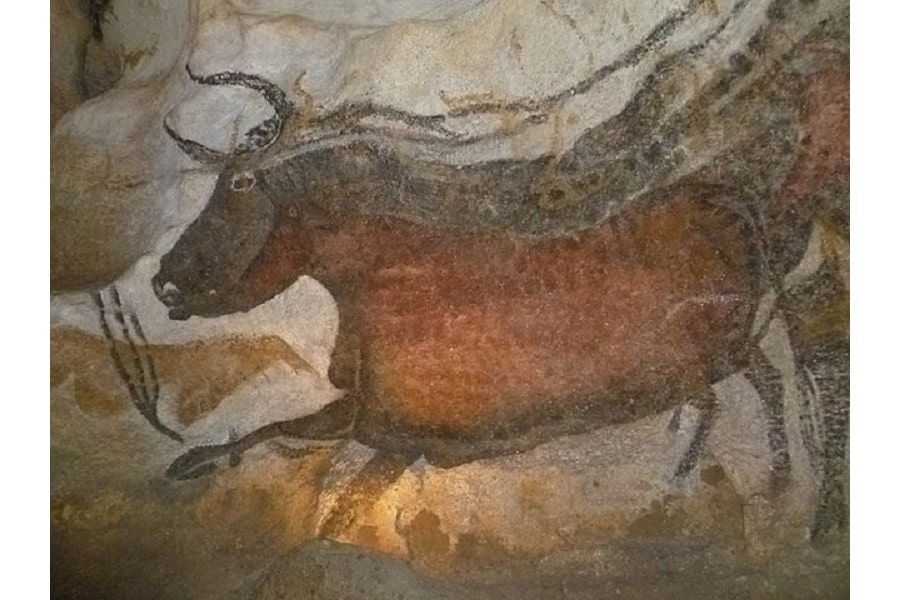
Dating from around 15,000 to 17,000 B.C.E., the images of Lascaux bear signs of great skill. Animals are shown in profile, yet often with added touches that give dimension – such as depicting horns as turned slightly toward the viewer, or the famous “Crossed Bison” image, in which two bison are depicted with one partially obscuring the other.
The paintings predominantly use combinations of red (made from hematite and ochre), yellow (iron oxyhydroxides), and black (charcoal or manganese oxides). In a number of places, the contours of the cave wall itself have been incorporated into the art, giving another example of the skill and thoughtfulness of the cave painters.
Divine Purpose
While it’s easy for modern eyes to see these painted caves as a simple decoration or a visual diary, there could well be more to them. The layout of the art in Lascaux and other caves in the region hints strongly at a shamanistic or spiritual function.
The paintings are not readily accessible, with many reached through difficult navigation via narrow passages well away from daylight – not areas in which people would have lived. Reaching the deepest and least accessible ones would have been an ordeal – especially with only some sort of primitive torch lighting the way – which to some seems evidence that it was meant as a shamanic journey.
Buttressing this idea is the fact that the most enigmatic scene in Lascaux – and the only representation of a human (or humanlike) figure – is in the very deepest part of the cave, in the area known as the Shaft. Here, a figure with a bird head (or perhaps a bird mask) seems to lie prone near what seems to be a bird-topped staff, with the cave’s only representation of a woolly rhino nearby. These drawings are not as complex as those closer to the entrance – perhaps reflective of the difficulty of creating art so deep into the cave, or alternately reflecting art made in an altered state.
Other Sites
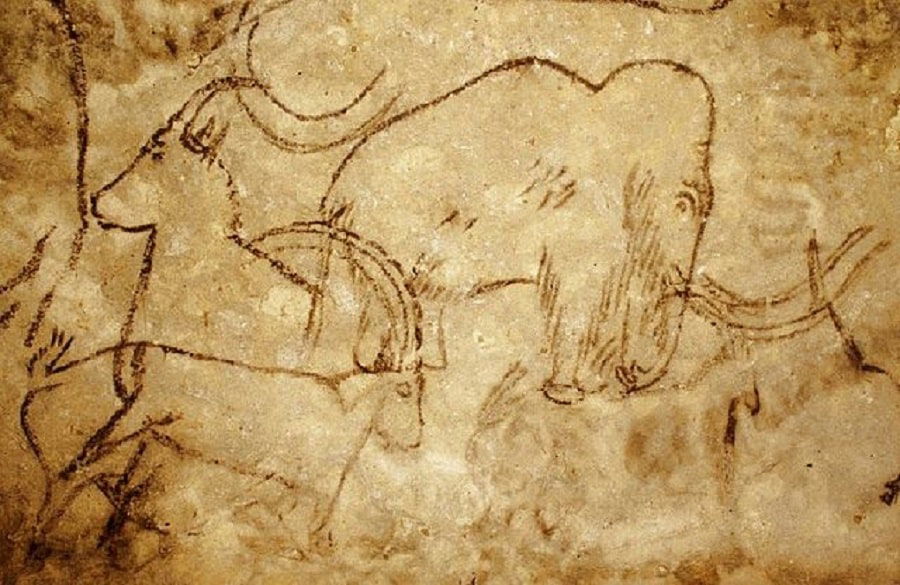
Lascaux stands out in the catalog of cave paintings, but it’s not the only site in the region. On the contrary, this area of Europe has a number of such sites, particularly in southwestern France and eastern and northern Spain.
A cluster of such caves sits around the area of Lascaux, including Rouffignac. Known since the 16th Century (but only officially “discovered” in 1956), Rouffignac is the largest cave system in the region and bears a few hundred depictions of animals – though these are mostly engravings or black contour drawings, not multicolor images such as those in Lascaux.
The nearby Chauvet-Pont-d’Arc Cave, one of a string of sites along the Ardéche River, lies some 350 km southeast of Lascaux. At Chauvet Cave are found the oldest cave paintings in France, dating from between 30,000 and 32,000 years ago.
And at Cueva de los Aviones in southeastern Spain comes the oldest cave art known. But this site boasts artwork not from early humans, Homo Sapiens, but from our relative Homo Neanderthalensis. The art – geometric shapes made in red pigment – dates back as far back as 115,000 years ago.
READ MORE: How Long Have Humans Existed?
Asia
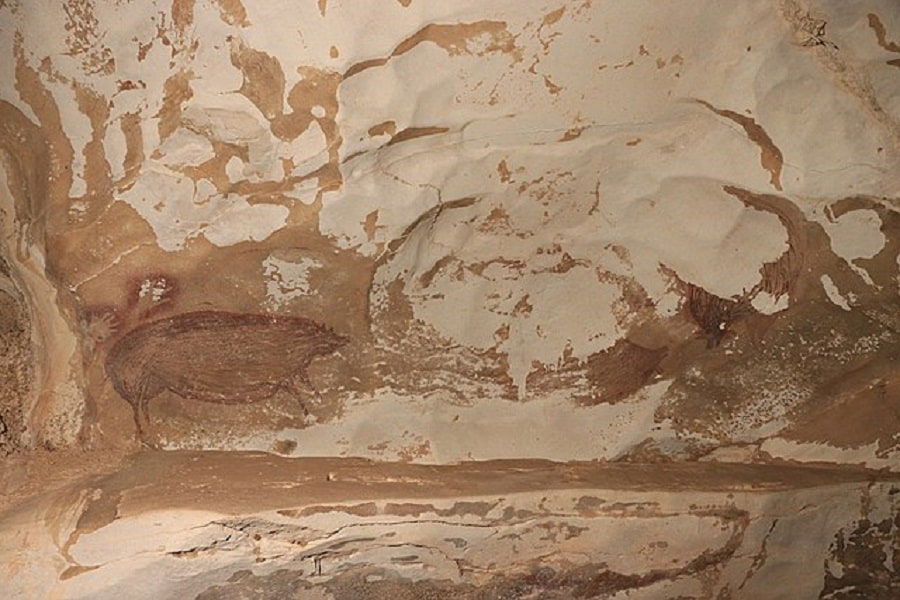
The oldest known cave painting by Homo Sapiens, however, is not among the famous caverns in France or Spain. That would be found far to the east – on the Indonesian island of Sulawesi, northeast of Bali.
Most of the artwork found on the grayish rock walls of the cramped cave called Leang Timpuseng (about an hour from the city of Makassar) is in the form of a series of handprints outlined in ochre (an ancient pigment made by mixing iron ore, in the form of iron oxide, with clay or sand. Scattered around the cave wall, there are not many in this site – but other caves and cliff walls, more easily accessible and touched by daylight, have been found with much higher concentrations, and by a mix of genders and ages that hint that these more available canvases were used by tribes as a whole – and uranium-thorium dating puts them at as much as 35,000 years old.
The First Picture
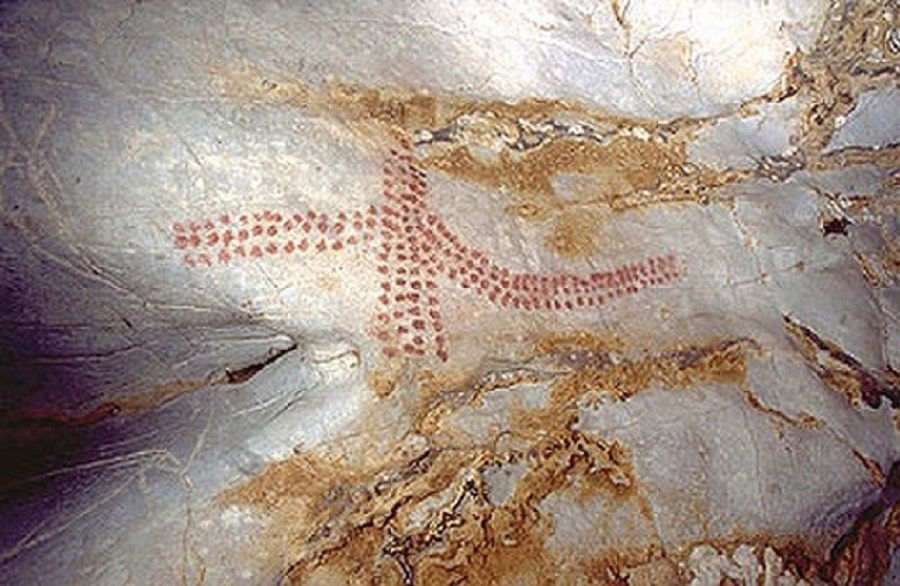
While not the oldest example of decoration on a cave wall – that honor goes to the El Castillo cave in Spain, which also bears handprints and an ochre disk which was dated to almost 40,000 years old by the same technique – something more than a simple hand stencil occupies the ceiling of Leang Timpuseng – a depiction of a babirusa, a species of swine was common in the area.
The image has stick legs, a round body, and no tusks – signifying a female – but it’s recognizably a babirusa. Dated at some 35,000 years old, it is, so far as is known, the first figurative art – the first depiction other than a simple shape or a stencil – in human history.
Modern Links
Hand stencils like those in Leang Timpuseng are not just relics of the past – they have remained part of the culture of the region right into the modern day. Even now, it is still customary to put a handprint – usually with a mix of rice powder and water – on the central pillar when building a new house.
And in nearby Papua, New Guinea, women of the Dani tribe – until the Indonesian government banned the practice – would sometimes amputate a finger or part of one when they lost a family member. The handprints at sites like Leang Timpuseng, some of which are notably missing fingers, hint that this tradition may have been another ancient link.
READ MORE: Ancient Civilizations Timeline: 16 Oldest Known Cultures From Around The World
Australia
Over a thousand miles southeast of Indonesia, the unique continent of Australia bears cave art of its own. It is nowhere near as old as that of Indonesia, but Australia boasts an impressive and diverse gallery larger than that of the rest of the world combined.
The oldest intact picture, a kangaroo found in the Kimberly region in north-western Australia, dates from roughly 17,000 to 17,500 years ago. But another image found off to the northeast in Arnhem land – a rock fragment bearing a few lines of a charcoal drawing, which seems to have fallen from a cave ceiling or wall at some point – dates from as early as 28,000 years ago. Petroglyphs in Australia – engravings in the rock as opposed to painting or stenciling – seem to be even older.
Ancient Connections
In Kimberly, cave walls bear ochre outlines of hands – stencils very much like those found in Indonesia. This makes sense in a historical context – humans came to Australia from Asia as early as 65,000 years ago, with Kimberly laying on the theorized migration route they would have used.
This is not to say that such stencils of hands outlined in pigment are unique to this region. On the contrary, they seem to be a near-universal expression of early human identity, found not only here but in the El Castillo cave of Spain and even in the cave art of South America – but combined with other similarities between Indonesian and older Australian cave art, along with other evidence of population migration, they are just one more sign of a direct linkage between the two areas.
But Also, Unique

Aboriginal art is far from derivative, however. It presents some very original iconography and style choices all its own, which reflect the depth and diversity of the various indigenous cultures of Australia.
For instance, take the Wandjina – rain and cloud spirits credited in some stories as creation gods in the vein of the Rainbow Serpent (another unique figure of Aboriginal cave art). Mouthless figures with large heads, the Wandjina are generally depicted with pigments in red, black, and yellow. They are of such deep cultural significance where they are found that tribes still maintain them, regularly repainting the figures to preserve their power.
Australian cave art also has a sizable collection of so-called “x-ray art,” in which the skeleton of a figure is depicted along with the body. While – like hand stencils – this art style has been found around the world, the scope and quality of the Australian depictions stand out.
Africa
It should be no surprise that the cradle from which man arose has its own rich hoard of cave paintings. With dozens of different artistic traditions which extend over numerous tribes and thousands of years, Africa holds a wealth of parietal art.
African rock art is a blend of geometric forms as well as human and animal figures and also features human-animal hybrids known as therianthropes. While not unknown in the cave art of other continents (they appear in Indonesian caves, as well as in the bird-headed figure of Lascaux), they feature heavily in Africa, particularly in the cave drawings of the Bushmen.
The Art of the Bushmen
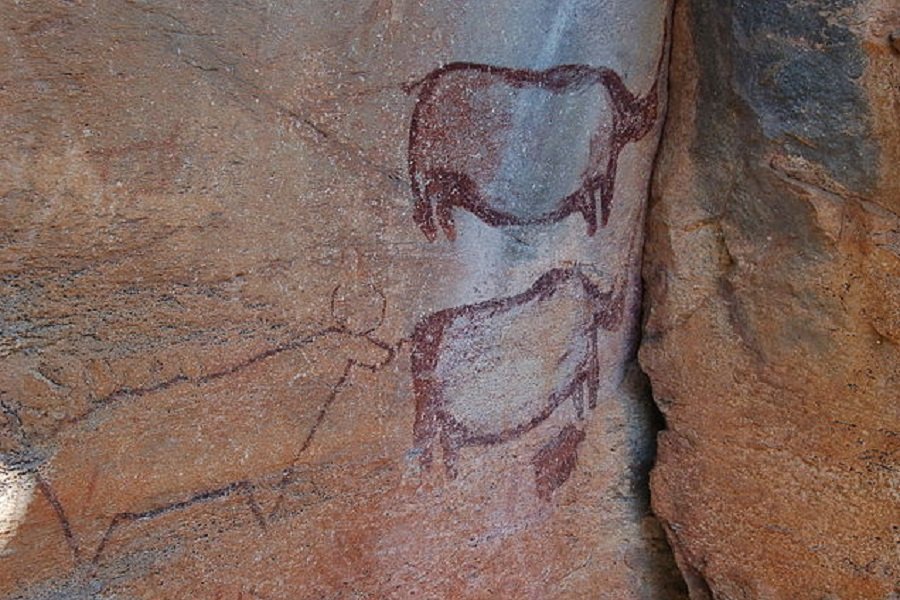
The various hunter-gatherer groups in Southern Africa known collectively as the Bushmen, such as the Kung, Khwe, and the Tshuwau, are one of the oldest cultures on Earth, reaching back to the very beginnings of humankind. And that long lineage is reflected in their artistic history.
The famous Tsodilo Hills UNESCO World Heritage Site holds red and white cave paintings that are as old as 24,000 years ago. And – while not a cave painting, per se – a rock fragment decorated with ochre lines found here has been dated to be 73,000 years old, making it the oldest known piece of Homo Sapiens art in the world.
The Art of the Batwa
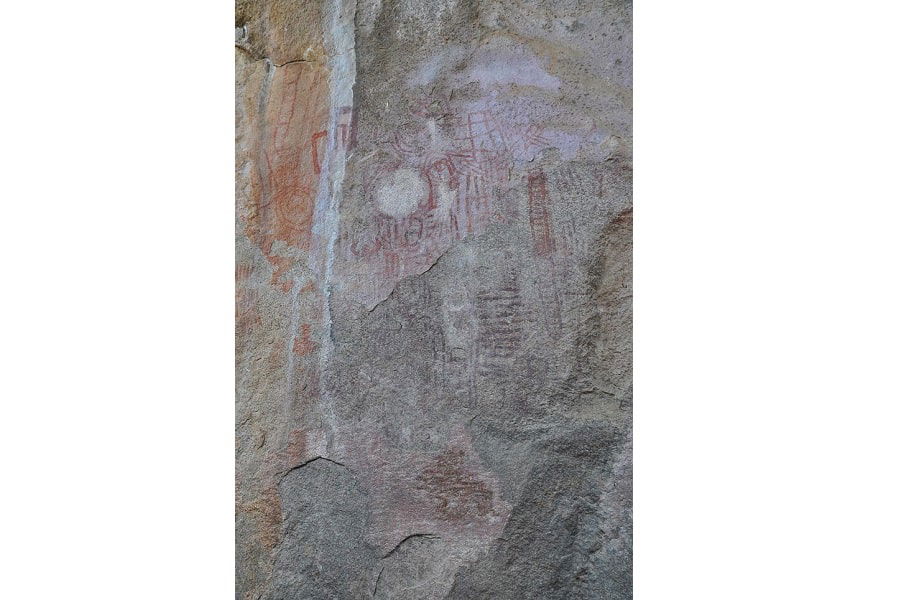
In Central Africa, the people remembered by modern Africans as the Batwa – but more popularly known as the Pygmies – left their own legacy of rock art. And while their range lay just across the Zambezi River from that of the Bushmen, there seem to have been profound cultural differences.
Rock art in this area of Africa is dominated by geometric patterns, along with a smaller sampling of animal forms stylized to the point of distortion. They seem to have worked almost entirely in red ochre and used a finger-painting technique as opposed to the brush application the Bushmen used.
Northern Africa

The art of Northern Africa is wildly diverse. While it almost exclusively takes the form of engravings until about 8,000 B.C.E., the later periods in this region begin to see paintings of wild and domestic animals, gods and mythical creatures, and humans.
READ MORE: Pagan Gods from Across the Ancient World
At Tassil-n-Ajjer (“Plateau of Chasms”) in southeastern Algeria are found some 15,000 paintings and engravings, some of which extend back 12,000 years. The depictions here include humans engaged in dancing, hunting, herding, and other aspects of daily life, and among them are some of the largest depictions found on the African continent.
North America
But cave paintings aren’t limited to the Eastern Hemisphere – there are several examples in North America as well. None are as old as those found in the Eastern Hemisphere – the very oldest petroglyphs, found at Winnemucca Lake in Nevada, date to only about 10,000 to 15,000 years ago, and the oldest cave drawings, found in Tennessee, are only about half that old.
Still, North America’s collection of rock art remains a remarkable, diverse, and historically important record of human prehistory on the continent. Petroglyphs are found heavily across the American southwest, though individual examples are found from Massachusetts to the U.S. Virgin Islands to Alaska, but a rich bounty of cave paintings is concentrated in the southern United States.
Tennessee
The eight-mile-long Dunbar Cave sits just northwest of Nashville, the focal point of a state park that bears its name and an archaeological treasure trove. The cave bears signs of use or habitation as far back as 10,000 years ago, with an array of charcoal drawings and petroglyphs dating to the Mississippian, or “Mound Builder” era between 700 and 1,300 C.E.
READ MORE: Pyramids in America: North, Central, and South American Monuments
To the east lies another interesting find – Devilstep Hollow Cave. Similar to caves found in Europe and elsewhere, Devilstep Hollow seems to have constituted a kind of ritual space, with art leading one into the deepest chamber. Moving through constricted passages, visitors are guided by images of woodpeckers which give way to symbols of priestly authority and representations of the Mississippian deity known as the Falcon Warrior, clearly signifying a spiritual journey of some sort.
The images of Devilstep Hollow date from about the same period as those of Dunbar (though on the later end – 1,200-1,300 C.E.). But nearby, among the many samples of cave and cliff art found along the Cumberland Plateau in the eastern part of the state, are samples of cave art that go as far back as 6,000 years ago – the oldest such cave drawings in North America.
Alabama
The most extensive cave art in North America, however, remains hidden away. Somewhere on private land in Alabama sits a cave referred to by researchers only as the 19th Unnamed Cave – and it hides something so precious that it’s been protected by secrecy for over two decades.
First discovered in 1999, the low ceiling of the 19th Unnamed Cave boasts the largest cave images in North America. But the low ceiling made photographing these images nearly impossible – it wasn’t until 2017 that digital technology allowed the full scope of the images to be captured.
The ceiling holds four life-sized human figures – the largest one almost seven feet tall – and an 11-foot-long diamondback rattler (a sacred animal among Native groups in the region). The scale of the artwork, and the fact that it’s on a low ceiling in the dark zone of the cave, signify that these were important images – applying them would have been a difficult, painstaking, and well-planned process, and almost certainly marks them as having a religious or ritual function.
South America
But cave painting in the West is not found solely in the Northern Hemisphere. Even more wondrous prehistoric art can be found in South America, where well-preserved cave paintings and archaeological sites testify to an earlier human presence than any uncovered so far in North America.
Found in the dark recesses of caves, shallower rock shelters, and even open cliff faces, art in South America is a stunning collection of paintings, engravings, and carvings. And like cave art from the rest of the world, it shows clear evidence of cultural and religious significance to the artists who made it.
Cave of Hands
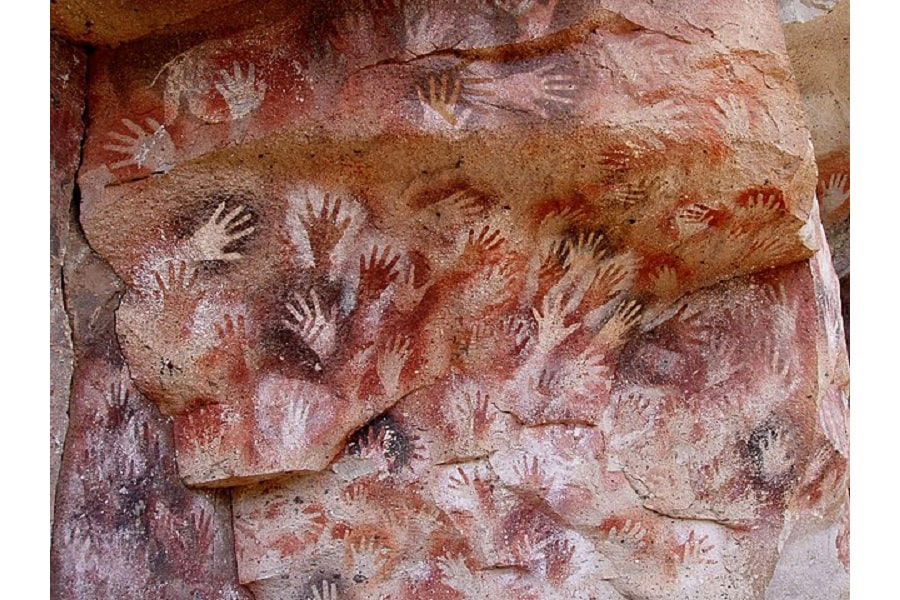
Patagonian Argentina is home to one of the most important examples of cave art in South America – the Cueva de las Manos, or Cave of Hands. Believed to have been a stopping point on a nomadic circuit of hunter-gatherers for millennia, the cave is now a UNESCO World Heritage Site.
The cave holds over two thousand handprints, most using the classic stenciling technique found around the world with a mix of red, yellow, white, and black pigments. The cave walls also show human and animal figures, depictions of hunts, and geometric designs.
Radiocarbon dating has confirmed that the artwork was applied in multiple layers, beginning as early as 7,500 B.C.E. and continuing until about 700 C.E. This means the cave was used by nomadic people in the region for a staggering eight thousand years and the presence of foreign substances like obsidian in the cave area hint that it was perhaps a trade as well as religious center at least part of that time.
Serra da Capivara
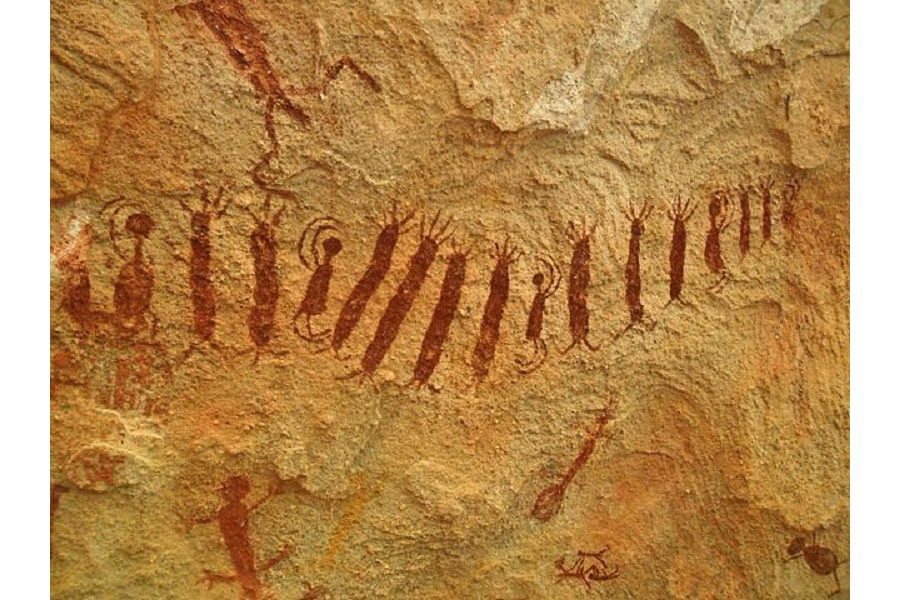
But it’s in Brazil’s Serra da Capivara National Park where we see the oldest cave paintings in the Americas. Officially dated at some 25,000 years old (but, according to some experts, perhaps as much as 36,000 years old), the paintings at Serra da Capivara upend the traditional “Clovis” model of human dispersion in the Western Hemisphere, well predating the Bering Sea land bridge by which humans supposedly arrived in the West.
The controversial art was painted in red, yellow, and gray pigments, and generally features large panels of human and animal figures dancing, fighting, hunting, and sometimes seeming to move in great processions.